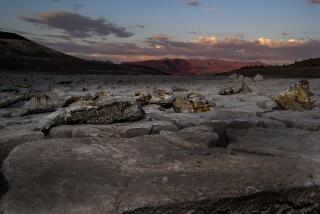Farmers’ Face a Harvest of Dust in Great Plains
- Share via
BEAVER, Okla. — C.J. Rose squints beneath his sweat-stained cap and scans the sun-scorched wheat fields that support his family. What he sees scares him.
Dead tired and coated with dust, the lanky farmer-rancher has little to show for months of plowing and planting but a stretch of shriveled stalks of wheat embedded in crusty, parched earth.
“It’s been like the dream you always had has come to an end in a cloud of dust,” Rose says, his voice husky, his shoulders slumped in dejection. “What people don’t understand is I can work all year as hard as I can and I’m not going to get paid for it.”
Harvest has come to the Great Plains and fears of failure--or even total collapse--loom for thousands of wheat farmers and cattle ranchers struggling through one of the worst droughts this patch of the Panhandle has seen since the Dust Bowl. Oklahoma’s losses alone will exceed a billion dollars.
It has been a domino-like disaster: No rain means no grain. No grass for cows to graze. Lighter cattle mean lower prices. And less money means more trouble for Carl J. Rose, who works the same land his father tended and his grandfather homesteaded 75 years ago.
“It seems like the harder we try, the worse we get,” the 36-year-old farmer says, grabbing a chunk of cocoa-colored dirt so dry it slips through his fingers like sand. “I’ve never been so depressed in my whole life.”
Come July, Rose faces his first financial squeeze: $30,000 in bills. A small plot of decent-sized wheat he expected to salvage was destroyed, ironically, by water--a May hailstorm. He didn’t sell his cattle, either, because they wouldn’t bring what he owes on them.
So he trudges on, working a second job with the county road department, rattling along in his rusty 1980 blue Chevy pickup that has logged 200,000 miles and hoping his bank will help him hang on.
“I’d hate to leave,” says Rose, whose family name has been on the deed to this land ever since the county started keeping records. “I’ve got a little boy who’s 6 years old. All he wants to do is farm. I’d sure like for him to farm. I’d like for him to eat. You can’t do both. At least it seems that way.”
*
For many here, this will be a harvest of hardship.
In the Beaver County area, where nature’s caprices can make or break lives, only 1.6 inches of rain fell from October through April--slightly more than a quarter the normal amount of precipitation.
Oklahoma is expected to have its smallest wheat crop in 25 years.
Up to 85% of the county’s winter wheat--including abandoned acres--could be lost. Some area farmers, having endured drought, hail and a freeze the last three years, face a possible fourth straight disaster.
Already, trouble signs are evident along the two-lane blacktops that snake through this remote region, where the howls of coyotes pierce the night and a mere 6,000 souls share an area larger than all of Rhode Island (home to more than 1 million people).
Normally, the fields are filled with lush, golden grain so thick that it covers the ground like a blanket. Now, there are sickly, ankle-high strands of wheat sprouting from land with cracks so wide you can fit your hand in them.
This is ranching country, too--a roadside sign proclaims “Watch Your Curves, Eat More Beef”--but livestock dealers haven’t fared much better with cattle prices at a five-year low.
With pastures too dry for grazing and feed costs too high, many ranchers were forced to sell off herds at lower weights and cheaper prices--sometimes a half or a third of last year’s going rates.
“They don’t want to get rid of their factories. It’s their livelihood,” says Bill Skaggs, standing in his Beaver City Stockyards, surrounded by cowboy paintings, a mounted elk’s head and a stuffed coiled snake. “It’s really a Catch-22. They’re just doing what they need to survive. That’s all.”
But that’s become harder with increasing business costs: Fertilizer prices rose by as much as 75% and diesel prices by up to 50% over a year ago.
“It’s very hard to make it,” says farmer-rancher Jerald Radcliff. “You cannot stop the expenses. You spend $75 to $80 an acre to plant the crop, then you don’t get anything in return.”
The Drought of ’96 already has ravaged wide stretches of the Plains, causing staggering losses for parts of Kansas, Colorado and New Mexico and large sections of Oklahoma and Texas.
Texas, for instance, is enduring its second-worst natural disaster--behind 1983’s Hurricane Alicia with its $3-billion price tag. If there isn’t significant rain during the summer, the $2.4-billion drought loss could double by September, state experts say.
Oklahoma faces more dire predictions: State agriculture officials in May estimated drought-related losses at up to $1.2 billion, with about 10% of the 71,000 producers expected to go bankrupt or quit farming.
“If somebody gave up a piece of land 10 years go, there’d be a number of people waiting in line to farm it,” Radcliff says. “Today, you’d have to go begging.”
The drought inevitably brings comparisons to the “Dirty ‘30s,” the local nickname for the Dust Bowl days, when fierce winds whipped up clouds of dirt so dense it buried homes, turned roads into dunes and day into night.
Those scenes won’t recur. More sophisticated farm tools, replanting and different conservation methods reduce wind erosion and prevent the soil from blowing away into dust.
Still, some see that hard-luck era as the yardstick of endurance.
“I read the Book of James a whole lot,” says Guy Payne, a fifth-generation rancher who works a second job processing animals at a feed lot in Kansas. “It has a lot about trials and tribulations.”
“There’s guys who made it in the ‘30s,” he says. “There’s guys who are going to make it in the ‘90s. And I’m going to be one of them.”
*
Chris Smith didn’t make it.
After 13 years of building his cattle herd, Smith, 36, was forced to sell his animals this spring and give up the only life he’s ever had--and ever wanted.
His debts had surpassed $400,000, his bank wouldn’t give him any more loans and there was no grass to feed the cattle, no money to buy alfalfa and no way to make ends meet.
“It’s been an extremely painful ordeal,” says Smith, a short, husky man with a gentle manner. “It’s like when a loved one is dying of a slow cancer that is eating them away. The end is near, but you hold on as long as you can.”
Smith had been in trouble for a decade but thought he and his wife, Judy, could lease some grassland so that one day they could pass their farm to a fourth generation, their 14-year-son.
The drought changed that.
Smith fits into the category bankers say are at greatest risk: younger, highly leveraged producers who were on the edge even before the drought.
So on a morning in late May, Smith hauled the last 120 of his herd on a 25-mile drive from his home in Meade, Kan., to the Beaver City Stockyards, which has seen its business double in recent months.
Smith’s beloved animals were hustled into a ring as the auctioneer’s hiccuping patter filled the air. Tobacco-chewing buyers in straw cowboy hats and silver spurs quietly bid with a few hand signals.
Within moments, his animals were sold--for about 50% of last year’s prices.
“It was like selling part of my family,” Smith says, his eyes welling with tears. “But when the figures don’t add up to pay all the bills and a drought is facing you, you have to be realistic. You have to get what you can.”
He says he has reduced his debts to more than $100,000, but still worries. “You can’t breathe a sigh of relief because you don’t know what the banks are going to do,” says Smith, the father of four.
Smith hopes to make a deal with his creditors that will avoid bankruptcy, and he knows he’s in for a period of adjustment.
He admits, too, that he still is haunted by decisions he made that put him in this predicament, and he wonders if he would have been better off if he had quit earlier.
“Sure, you beat yourself up,” he says. “I second-guess everything. . . . But I don’t feel so bad, because the drought is pushing a lot of us over the edge. The one thing you can’t second-guess is the weather.”
More to Read
Sign up for Essential California
The most important California stories and recommendations in your inbox every morning.
You may occasionally receive promotional content from the Los Angeles Times.










